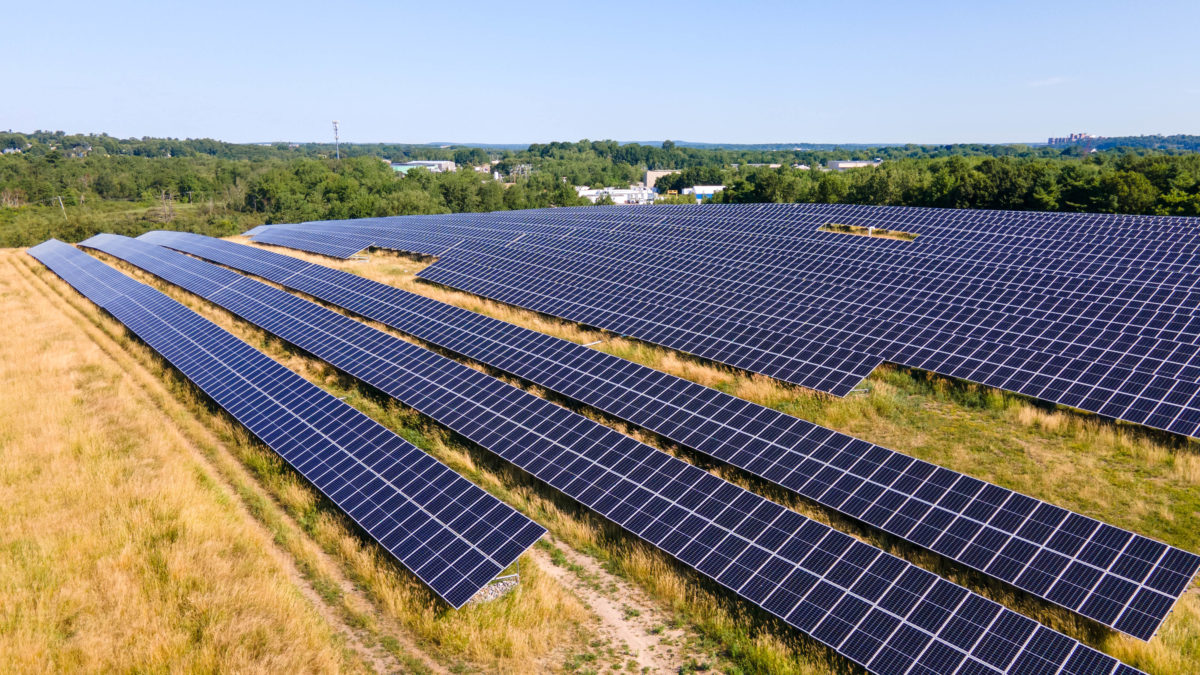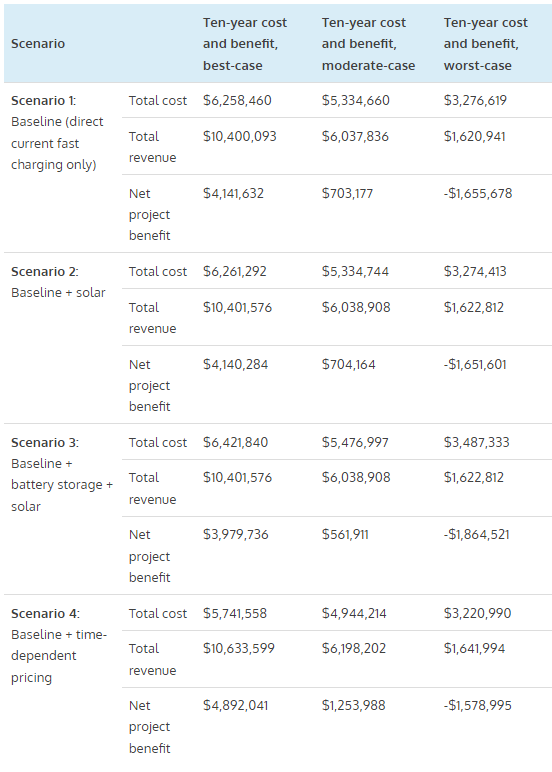From brownfield to green wellspring
February 13, 2023
By Ryan Kennedy in pv magazine USA
Plots of land abandoned as graveyards of hazardous materials are being reborn as clean energy hubs. pv magazine USA’s Ryan Kennedy looks at the diverse opportunities for solar, energy storage, and electric vehicle (EV) charging station developers.

Landfill East in South Portland, Maine.
Image: ReVision Energy
The old adage “one man’s trash is another’s treasure” is being applied to brownfield and landfill sites across the United States as PV projects and electric vehicle charging hubs are beginning to top sites that were once deemed irremediable.
A study by the Rocky Mountain Institute (RMI) in 2021 showed that landfills in the United States could host more than 63 GW of solar capacity, generating 83 TWh of electricity each year. This would equate to $6.6 billion in annual electricity revenues, according to RMI. There are more than 10,000 closed and inactive landfills across the nation. These sites often offer good sun exposure and little opportunity for other uses. Moreover, landfills and other hazardous sites are often located in Environmental Justice communities – low-income areas disproportionately affected by pollutants and other negative externalities from industry.
The Environmental Protection Agency (EPA) aids the redevelopment of “superfund” sites, plots of land that were contaminated and are repurposed for productive means. As of the end of last year, the EPA reported 106 completed superfund projects, combining for a sizeable 512 MW of generation capacity. Solar makes up most of the portfolio, contributing 372 MW across 86 projects. Connecticut, Massachusetts, New Jersey, and New York are home to 73% of US utility-scale landfill solar projects. Approximately 60% of the sites to receive funding for new cleanup projects are in historically under-served communities, according to the EPA.
The federal agency has evaluated the revitalization potential more than 190,000 formerly contaminated lands, landfill sites, and mine areas covering nearly 44 million acres across the United States. These sites are included in the EPA’s RE-Powering Mapper, which locates such areas and provides information about them, and their potential for supporting renewable energy generation.
Phoenix rising
FirstEnergy Corp, a utility serving West Virginia in the heart of US coal country, has announced it will permanently retire a coal ash facility. Like a phoenix rising from the ashes, a solar project will take its place. The utility is planning a 6 MW site as part of a larger, 50 MW solar portfolio. Coal ash, the byproduct of burning coal for electricity, is the second largest waste stream in the US, behind household trash. It contains toxic substances including arsenic and lead and is generally buried in a processing landfill. The FirstEnergy facility had been using the ash to produce cement and the utility buried toxic materials in a landfill.
Environmental justice
The US Inflation Reduction Act, which sets aside $369 billion for climate and energy spending, targets environmental justice communities as an important focus for the energy transition. Included in the act is a $27 billion clean energy technology accelerator program that will support the deployment of technology to reduce emissions in disadvantaged communities. Funded at $3 billion, Environmental and Climate Justice Block Grants are allocated for investment in community-led projects that address disproportionate environmental and public health harms related to pollution and climate change. A further $3 billion will be used to fund Neighborhood Access and Equity Grants. The awards are designed to support neighborhood equity, safety, and affordable transportation access. Four competitive grants aim to reconnect communities divided by existing infrastructure barriers. These will seek to mitigate the negative impacts of transportation facilities or construction projects on disadvantaged or under-served communities, support equitable transportation planning and community engagement activities.
FirstEnergy subsidiary Mon Power will construct the solar project on the 27-acre site and another solar farm will be installed on a 44-acre reclaimed coal strip mine property. Mon Power and utility Potomac Edison are accepting applications to subscribe to a utility-run community solar program. The scheme would enable customers to purchase renewable energy credits representing the production of the solar facilities. The credits are then used to offset utility bill costs.
Charging hub
East Bay Community Energy (EBCE) is a California Bay Area not-for-profit public agency that procures renewable energy to be delivered, via utility Pacific Gas and Electric’s (PG&E) lines, as a “community choice energy service.” The group was awarded an EPA National Notable Achievement Award last year for going beyond power procurement and performing a successful pilot demonstration of the revitalization of brownfield sites as EV charging hubs.
In May 2021, East Bay Community Energy was awarded a $300,000 grant by the EPA to develop an inventory of brownfield sites throughout its service area that could be a good fit for redevelopment as fast charging hubs for light, medium, and heavy-duty electric vehicles.
The EPA’s Land Revitalization Program provided East Bay Community Energy with contractor technical assistance to help determine the environmental and economic feasibility of redeveloping brownfield sites along Interstate 880 into EBCE fast charging hubs. The analysis involved the development of a financial pro-forma model that anticipated redevelopment costs and benefits under best-, moderate- and worst-case scenarios.
Economic feasibility of a planned light-duty vehicle charging station over 10 years, under best-, moderate-, and worst-case cost and revenue assumptions

Source: US Environmental Protection Agency.
The model evaluated environmental cleanup and EV equipment costs, station utilization rates, electricity pricing, low-carbon fuel credits, and options involving the co-location of solar panels and battery energy storage. The analysis outlined the key variables that EBCE needed to understand to make the fast-charging hubs viable.
The pro-forma analysis concluded that utilization rates of EV charging hubs are critical; the greater the utilization, the more financially viable an EV charging station will be. It also found that co-locating battery energy storage increases the community benefit of these sites and that engaging in time-dependent pricing can improve payback periods for these facilities.
“This project brings the potential for many local wins,” says Elisa Marquez, Hayward City Council member and a member of EBCE’s board of directors. “It addresses several dire environmental issues, including redeveloping contaminated brownfields, bringing economic prosperity to dormant urban land, and creating opportunities to expand the adoption of clean, electric transportation.”
Oil to solar
One success story shared by the EPA was that of the Pacific Coast Pipeline project in Fillmore, California. Since 1928, oil giant Texaco (now Chevron) has run a refinery at the site. Negligent disposal practices contaminated the soil and groundwater and Texaco closed the operation in 1950.
The EPA added the site to a national priority list of superfund locations in 1989. From 1992 to 2002, the EPA began revitalization efforts through a pump and treat process. Chevron dug up and disposed of 42,000 cubic yards of contaminated soil and placed it in a capped area. By 2014, the EPA deemed the site to be ready for commercial and recreational use.
In 2016, developer Cenergy Power leased the site property and developed a 3 MW solar project. The 11,000-module facility began operations in September 2021, delivering electricity to Ventura County end-users.
The solar site reduces the county’s emissions by roughly 5% and is expected to save up to $4.5 million over its 25-year planned lifetime. “The solar field didn’t require any investment on the part of the county but will save the county approximately $100,000 per year while providing a significant portion of our electricity in the form of clean solar power,” said David Sasek, director of Ventura County General Services Agency. “This really was a win-win solution.”